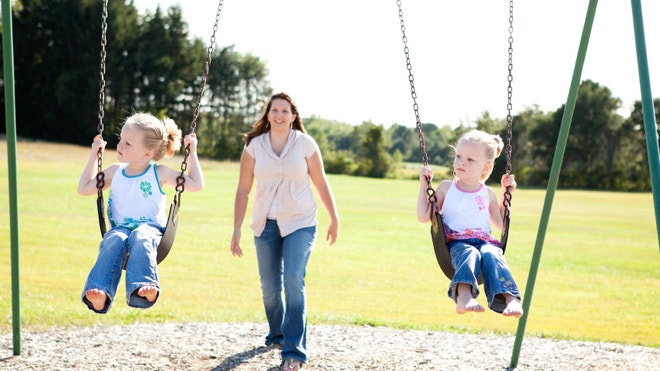
Getting adults to be more active on visits to children’s playgrounds could be as simple as removing the temptation to sit, a small new study suggests.
Inspired during his daily lunchtime walks by the sight of parents sitting on playground benches, a U.S. researcher has shown that moving the seating away from the area increased the amount of exercise that parents and caregivers got as they watched their kids.
“For such an easy and inexpensive change, we were able to shift many adults from sitting to standing and that alone promotes health,” said lead author James Roemmich, a supervisory research physiologist at the U.S. Department of Agriculture in Grand Forks, North Dakota.
The study, published in the journal Preventive Medicine, focused on a single playground in Grand Forks, where parents tended to congregate at eight picnic tables with benches and watch their children. The researchers observed playground activity by adults and children for a week with the benches present, and for another week after they were taken away, then again for a week when the benches were returned.
When the benches were removed, the adults were as much as 23 times more likely to engage in moderate to vigorous activity, the researchers found.
With benches gone, the parents were “walking around following their child, watching them play, swinging or pushing children on swings, walking around and socializing with other parents, walking through the splash pad to cool off, playing with the kids/lifting kids up to monkey bars and other play equipment,” Roemmich told Reuters Health in an email. “A couple times they brought a Frisbee or football and threw them around with the kids.”
Removing the benches did not affect the amount of time adults were willing to let the children stay and play at the park, the researchers point out in their report.
They also found that removing the benches did not make the children more active.
“That’s because children are already very active when they’re at the playground, running from swings to slides, climbing and jumping,” Roemmich said. “Increasing their activity level is more challenging.”
The one thing that did tend to increase children’s activity level, Roemmich said, was if they arrived at the park with a friend or sibling. That “social facilitation,” he said, upped kids’ activity level because much active play typically requires partners.
Research also suggests that children play more if their parents aren’t hovering too close, Roemmich notes. “I’m not advocating leaving kids at the playground unsupervised, just give them some space,” he said.
The 17-acre park where the study was conducted is across the street from Roemmich’s office, so he passed by it daily.
“I saw a terrific playground there, and I noticed that the parents or adult caregivers were sitting while kids were playing,” he said. “I thought, ‘Wow, what a terrific opportunity for parents not to be sitting.'”
Roemmich said the study is an example of a “micro-environmental” change – a small alteration that can sometimes change behavior. Other micro-environmental changes include painting portions of the playground in bright colors and adding playground equipment – both of which have been shown to increase activity levels in children.
James Sallis, a professor of family and preventive medicine at the University of California, San Diego, said one of the virtues of this study is that “it could really be done in virtually any park or playground.”
Sallis, who was not connected with the study, is director of Active Living Research, an organization that supports research designed to promote physical activity in children and families.
“There’s a lot of applicability,” Sallis said, noting that removing benches is easy and inexpensive. “People are always looking for something you can do that’s cheap.”
“You could argue that it’s just a little bit of activity,” he said. “But that’s how we got to be an inactive society to begin with, with a million tiny little decisions like that. Who decided you needed benches in every playground?”
When asked if parents objected to the removal of the benches during the study, Roemmich said the parks department got “three or four complaint calls” from parents unhappy with the removal of the benches. “But once it was explained that it was a study, they were okay with it,” he said.
Sallis said he wishes the study had gone a step further and looked at whether removing the benches facilitated social activity among the adults.
“People tend to go to their own separate seat,” he said. “But if you’re standing up and wandering around, you may be more likely to have some social interaction – that could be an additional benefit,” he said.
Sallis also suggested that a next step to encourage adult activity might be to put adult exercise equipment on the periphery of the playgrounds.
Source: Fox news


